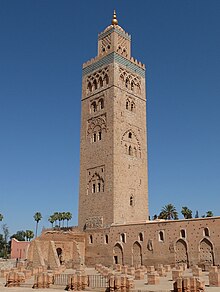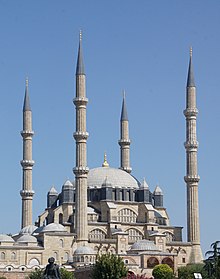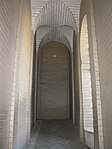Minaret

A minaret (
Etymology
Two Arabic words are used to denote the minaret tower: manāra and manār. The English word "minaret" originates from the former, via the Turkish version (minare).[5]: 46 [6]: 132 The Arabic word manāra (plural: manārāt) originally meant a "lamp stand", a cognate of Hebrew menorah. It is assumed to be a derivation of an older reconstructed form, manwara. The other word, manār (plural: manā'ir or manāyir), means "a place of light". Both words derive from the Arabic root n-w-r, which has a meaning related to "light".[5]: 46 Both words also had other meanings attested during the early Islamic period: manār could also mean a "sign" or "mark" (to show one where to go) and both manār and manāra could mean "lighthouse".[5]: 46–47
Functions

The formal function of a minaret is to provide a vantage point from which the
Additionally, minarets historically served a visual symbolic purpose.[8] In the early 9th century, the first minarets were placed opposite the qibla wall.[a][5] Oftentimes, this placement was not beneficial in reaching the community for the call to prayer.[5] They served as a reminder that the region was Islamic and helped to distinguish mosques from the surrounding architecture.[9] They also acted as symbols of the political and religious authority of the Muslim rulers who built them.[8][10]
Construction and design
The region's socio-cultural context have influenced the shape, size and form of minarets.[11] Different regions and periods developed different styles of minarets. Typically, the tower's shaft has a cylindrical, cuboid (square), or octagonal shape.[3][5] Stairs or ramps inside the tower climb to the top in a counter-clockwise fashion. Some minarets have two or three narrow staircases fitted inside one another in order to allow multiple individuals to safely descend and ascend simultaneously.[12][3] At the top of the stairs, a balcony encircles the upper sections of the tower and from here the muezzin may give the call to prayer.[13] Some minaret traditions featured multiple balconies along the tower's shaft.[3] The summit often finishes in a lantern-like structure and/or a small dome, conical roof, or curving stone cap, which is in turn topped by a decorative metal finial.[14][5] Different architectural traditions also placed minarets at different positions relative to the mosque. The number of minarets by mosques was also not fixed: originally only one minaret accompanied a mosque, but some later traditions constructed more, especially for larger or more prestigious mosques.[3][15]
Minarets are built out of any material that is readily available, and often changes from region to region.[5] In the construction of the tall and slender Ottoman minarets, molten iron was poured into pre-cut cavities inside the stones, which then solidified and helped to bind the stones together. This made the structures more resistant to earthquakes and powerful winds.[12]
- Elements of typical minaret design
-
Inside the stairway of a minaret in Mostar
-
An ornate balcony at the Qutb Minar in Delhi
-
Example of a lantern structure at the top of a minaret at the Badshahi Mosque in Lahore
Origins

The earliest mosques lacked minarets, and the call to prayer was often performed from smaller tower structures.[5][16][17] The early Muslim community of Medina gave the call to prayer from the doorway or roof of the house of Muhammad, which doubled as a place for prayer, and this continued to be the practice in mosques during the period of the four Rashidun Caliphs (632–661).[5]: 23, 28 [3]
The origin of the minaret is unclear.
References on Islamic architecture since the late 20th century often agree with Bloom's view that the mosques of the Umayyad Caliphate did not have minarets in the form of towers.
A possible exception to the absence of tower minarets is documented in Caliph

The first known minarets built as towers appeared under Abbasid rule.[5] Four towers were added to the Great Mosque of Mecca during its Abbasid reconstruction in the late 8th century.[3] In the 9th century single minaret towers were built in or near the middle of the wall opposite the qibla wall of mosques.[5]: 72–79 These towers were built across the empire in a height to width ratio of around 3:1.[5]: 79 One of the oldest minarets still standing is that of the Great Mosque of Kairouan in Tunisia, built in 836 and well-preserved today.[5]: 73–75 [3][8][29] Other minarets that date from the same period, but less precisely dated, include the minaret of the Friday Mosque of Siraf, now the oldest minaret in Iran, and the minaret opposite the qibla wall at the Great Mosque of Damascus (known as the "Minaret of the Bride"), now the oldest minaret in the region of Syria (though its upper section was probably rebuilt multiple times).[3][8] In Samarra, the capital of the Abbasid Caliphate in present-day Iraq, the Great Mosque of Samarra was built in the years 848–852 and featured a massive helicoidal minaret behind its northern wall. Its design was repeated in the nearby Abu Dulaf Mosque (861).[5]: 76 The earlier theory which proposed that these helicoidal minarets were inspired by ancient Mesopotamian ziggurats has been challenged and rejected by some later scholars including Richard Ettinghausen, Oleg Grabar, and Jonathan Bloom.[28]: 30 [30]
Bloom also argues that the early Abbasid minarets were not built to host the call to prayer, but were instead adopted as symbols of Islam that were suited to important congregational mosques. Their association with the muezzin and the call to prayer only developed later.[5]: 64, 107–108 As the first minaret towers were built by the Abbasids and had a symbolic value associated with them, some of the Islamic regimes opposed to the Abbasids, such as the Fatimids, generally refrained from building them during these early centuries.[21][5] The earliest evidence of minarets being used for hosting the call to prayer dates to the 10th century and it was only towards the 11th century that minaret towers became a near-universal feature of mosques.[5]: xvii, 64
Regional styles
China
Next to the Huaishengsi Mosque in Guangzhou is the Tower of Light, also known as the Guangta minaret (1350). The mosque and the minaret merge aspects of Islamic and Chinese architecture. Its circular shaft and the double staircase arrangement inside it resembles the minarets of Iranian and Central Asian architecture, such as the Minaret of Jam.[31]
Egypt

The style of minarets has varied throughout the history of Egypt. The minaret of the 9th-century Ibn Tulun Mosque imitated the spiral minarets of contemporary Abbasid Samarra, though the current tower was reconstructed later in 1296.[32]: 9 Under the Fatimids (10th-12th centuries), new mosques generally lacked minarets.[33] One unusual exception is the Mosque of al-Hakim, built between 990 and 1010, which has two minarets at its corners. The two towers have slightly different shapes: both have square bases but one has a cylindrical shaft above this and the other an octagonal shaft. This multi-tier design was only found in the minarets of the great mosques at Mecca and Medina at that time, suggesting a possible link to those designs. Shortly after their construction, the lower sections of the minarets were encased in massive square bastions, for reasons that are not clearly known, and the tops were rebuilt in 1303 by a Mamluk sultan.[32]: 17–18 [34][35]: 243
Under the
Later minarets in the
: 77–80Iran, Central Asia, and South Asia

Starting with the Seljuk period (11th and 12th centuries), minarets in Iran had cylindrical shafts with square or octagonal bases that taper towards their summit. These minarets became the most common style in the eastern Islamic world (in Iran, Central Asia, and South Asia).[24] During the Seljuk period minarets were tall and highly decorated with geometric and calligraphic design. They were built prolifically, even at smaller mosques or mosque complexes.[39]: 333 [24] The Kalyan Minaret in Bukhara remains the most well known of the Seljuk minarets for its use of brick patterned decoration. The tallest minaret of this era, the Minaret of Jam, in a remote area of present-day Afghanistan, was built c. 1175 by the Ghurids and features elaborate brick decoration and inscriptions.[39]: 333 The Qutb Minar in Delhi, the most monumental minaret in India, was built in 1199 and was designed on the same model as the Minaret of Jam.[3]

In later periods, however, minarets in this region became generally less monumental in comparison with the mosques for which they were built.[24] The tradition of building pairs of minarets probably began in the 12th century, but it became especially prominent under the Ilkhanids (13th-14th centuries), who built twin minarets flanking important iwans such as the mosque's entrance.[24]
The rise of the Timurid Empire, which heavily patronized art and architecture, led to what is now called the "international Timurid" style which spread from Central Asia during and after the 15th century.[40][41]: 69 It is categorized by the use of multiple minarets. Examples of this style include the monuments of Mughal architecture in the Indian subcontinent, such as the minarets on the roof of the south gate in Akbar's Tomb at Sikandra (1613), the minarets on the Tomb of Jahangir (1628-1638), and the four minarets surrounding the mausoleum of the Taj Mahal.[40] Elsewhere in India, some cities and towns along the coast have small mosques with simple staircase minarets.[42]
Iraq
The oldest minarets in Iraq date from the Abbasid period. The Great Mosque of Samarra (848–852) is accompanied by one of the earliest preserved minarets, a 50-metre-high (160 ft) cylindrical brick tower with a spiral staircase wrapped around it, standing outside the walls of the mosque. It is the tallest of the early minarets of the Abbasid period and remains the most massive historic minaret in the world, involving over 6000 cubic meters of brick masonry.[5]: 76 The Abu Dulaf Mosque, built near Samarra and finished in 861, has a smaller minaret of similar shape.[5]: 76 [8]
In the later Abbasid period (11th to 13th centuries), after the Seljuk period, minarets were typically cylindrical brick towers whose square or polygonal bases were integrated into the structure of the mosque itself. Their main cylindrical shafts were tapered and culminated in muqarnas cornices supporting a balcony, above which is another small cylindrical turret topped by a dome. Two examples of this style are the Mosque of al-Khaffafin and the Mosque of Qumriyya.[43]: 312
Maghreb and al-Andalus

Minarets in the
The minaret at the
Turkey

The Seljuks of Rum, a successor state of the Seljuk Empire, built paired portal minarets from brick that had Iranian origins.[24] In general, mosques in Anatolia had only one minaret and received decorative emphasis while most of the mosque remained plain.[24] Seljuk minarets were built of stone or brick, usually resting on a stone base, and typically had a cylindrical or polygonal shaft that is less slender than later Ottoman minarets. They were sometimes embellished with decorative brickwork or glazed ceramic decoration up the level of their balconies.[48]: 372
Ottoman architecture followed earlier Seljuk models and continued the Iranian tradition of cylindrical tapering minaret forms with a square base.[3][24] Classical Ottoman minarets are described as "pencil-shaped" due to their slenderness and sharply-pointed summits, often topped with a crescent moon symbol. The presence of more than one minaret, and of larger minarets, was reserved for mosques commissioned by the Ottoman sultans themselves. Taller minarets often also had multiple balconies (known as şerefe in Turkish) along their shafts instead of one.[24][3] The Üç Şerefeli Mosque in Edirne, finished in 1447, was the first sultanic mosque to have multiple minarets with multiple balconies. Of its four minarets, the northwestern minaret was the tallest Ottoman minaret up to that time, rising to 67 metres.[3][49]: 99–100 Its height was only surpassed by the minarets of the Selimiye Mosque in Edirne (1574), which are 70.89 meters tall and are the tallest minarets in Ottoman architecture.[41]: 226 [50] Later Ottoman minarets also became plainer and more uniform in design. The trend of multiple minarets culminated in the six minarets of the Sultan Ahmed Mosque (also known as the Blue Mosque) in Istanbul.[3]
See also
- Bell tower
- List of oldest minarets
- List of tallest minarets
- 2009 Swiss minaret referendum
- List of tallest mosques
Notes
References
- ^ "minaret". Random House Webster's Unabridged Dictionary.
- ^ a b "Miranet Function, Design & Importance". Britannica. Retrieved 2022-01-09.
- ^ ISBN 9780195309911.
- ^ "Miranet". World History Encyclopedia. Retrieved 2022-01-09.
- ^ OCLC 856037134.
- ^ ISBN 9780231101332.
- ^ a b "Mosque | place of worship". Encyclopedia Britannica. Retrieved 2018-12-12.
- ^ ISBN 9781134613663.
- ^ Weisbin, Kendra. "Introduction to mosque architecture". Khan Academy. Retrieved 2018-12-12.
- ^ ISBN 0197280137.
- ^ "Miranet". World History Encyclopedia. Retrieved 2022-01-09.
- ^ a b Gamm, Niki (March 9, 2013). "How to build a minaret". Hürriyet Daily News. Retrieved 2018-12-12.
- ^ Doğangün, Adem; İskender Tuluk, Ö; Livaoğlu, Ramazan; Acar, Ramazan. (May 2002). "Traditional Turkish minarets on the basis of architectural and engineering concepts". ResearchGate. Retrieved 2018-12-12.
- ^ al Safran, Mansour; Ghanaman, Shehdeh; Abu Awward, Bassam (2019). Architectural and Structural Behavior Domes in Islamic Architecture. American Research Institute for Policy Development. p. 43.
- ^ "Minaret | architecture". Encyclopedia Britannica. Retrieved 2018-12-12.
- ISBN 0905743636
- JSTOR 862832.
- ISBN 978-1-135-17960-1.
- ISBN 978-90-04-09372-0.
- The Burlington Magazine for Connoisseurs. 48.
- ^ ISBN 9781134613663.
Although the mosques of Damascus, Fustat and Medina had towers during the Umayyad period it is now generally agreed that the minaret was introduced during the Abbasid period (i.e. after 750 CE). Six mosques dated to the early ninth century all have a single tower or minaret attached to the wall opposite the mihrab. The purpose of the minaret in these mosques was to demonstrate the power of Abbasid religious authority. Those opposed to Abbasid power would not adopt this symbol of conformity, thus Fatimid mosques did not have towers.
- ^ Marchand, Trevor Hugh James (2012) [2001]. Minaret building and apprenticeship in Yemen. Routledge. pp. 22, 37.
- S2CID 134439335.
- ^ ISBN 9789004161214.
- ISBN 9789004161214.
- ISBN 9780195309911.
- ^ ISBN 9780300218701.
- ^ ISBN 9780300088670.
- ^ a b "Minaret of the Great Mosque of Kairouan". Qantara - Mediterranean Heritage. Retrieved 2022-04-26.
- ISBN 9789004161658.
- ISBN 9781119068662.
- ^ ISBN 9789774167324.
- ISBN 9781119068662.
- JSTOR 20847278.
- ^ a b c d e Williams, Caroline (2018). Islamic Monuments in Cairo: The Practical Guide (7th ed.). Cairo: The American University in Cairo Press.
- ^ ISBN 9789774160776.
- ^ Fraenkel, J.; Sadan, J. (April 24, 2012). "Manār, Manāra". Encyclopaedia of Islam, Second Edition.
- ^ ISBN 9789004096264.
- ^ ISBN 9781119068662.
- ^ ISBN 9781119068662.
- ^ ISBN 9780300064650.
- ISBN 9781119068662.
- ISBN 9781119068662.
- ^ a b Marçais, Georges (1954). L'architecture musulmane d'Occident. Paris: Arts et métiers graphiques.
- ISBN 978-3902782311.
- ISBN 9783902782199.
- ISBN 0870996371.
- ISBN 9783848003808.
- ISBN 0500274290.
- ISBN 978-3-11-063908-7.
Further reading
- Jonathan M. Bloom (1989), Minaret, symbol of Islam, Oxford University Press. ISBN 978-0-19-728013-3
External links
- "The Minaret, Symbol of a Civilization"
- . New International Encyclopedia. 1905.






